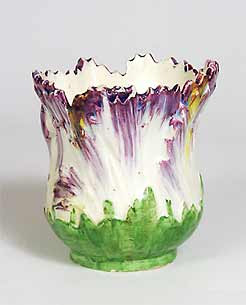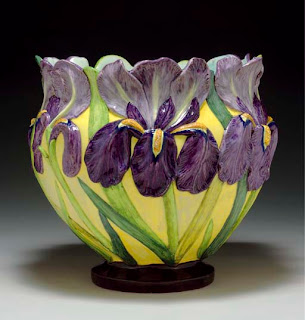One of the nice things about living in New York is that I get to see world famous landmarks like the Brooklyn Bridge every day. I pass it on the subway on my way to work as it dominates the East River on the south eastern part of Manhattan just south of the Manhattan Bridge.
Its fame is international and people come from all over just to walk it and marvel over its 129 year old walkways, but to us here in NY its utility is generally all we really think about.
Imagine my surprise when I stumbled into the Park Slope Gallery Web site to discover there is actually a majolica plate celebrating this marvel of Victorian architecture!
Among their collection of articles created in celebration of Brooklyn, the gallery has a majolica advertising piece created by Choisy-Le-Roi for Ehrich Brothers, a dry goods store (the equivalent of what we today call a department store). Located on a stretch of the Flatiron District called the "Ladies' Mile," the store operated from 1857 to 1911 in several locations, the last of which is now a Burlington Coat Factory.
On the gallery Web site they date the piece to 1915 which seems unlikely considering the store closed in 1911. Most likely it dates to the store's most profitable period from 1880 to 1900, which coincides with the completion of the Brooklyn Bridge in 1883. It was also a period of prodigious majolica production in Europe.
Within the next few years another NY store in the same neighborhood, Higgins & Seiter, would contract a line of majolica that would keep them famous among majolica collectors to this day.
If you're a collector of majolica, the name Higgins & Seiter means only one thing: Choisy-Le-Roi rabbit plates!
But the retail establishment of Higgins & Seiter was actually better known in their heyday as an importer of fine European china and cut glass. The company operated from the late 1860's until 1915. The onset of the first World War brought about the end of their import business and eventual bankruptcy. The company had several locations in the city on W. 21st Street, 22nd Street and E. 37th Street all within walking distance of the "Ladies' Mile."
The company also had a store on Bellevue Avenue in Newport, RI, which no doubt catered to the Oelrich's and Vanderbilt's insatiable appetite for extravagance.
Of course the company probably carried other majolica as well, but the Choisy bunny plates are what we associate with them today. Trademarked in 1900, I have never seen a bunny plate without the Higgins & Seiter mark, though I understand they did make them. The companion plates in the Choisy game bird series do not have this mark.
Both, the game bird plates and the bunny plates, can be found with a "Made in France" mark, which typically indicates production after 1919, so we can assume they both continued to be successful series' long after Higgins & Seiter folded.
Its fame is international and people come from all over just to walk it and marvel over its 129 year old walkways, but to us here in NY its utility is generally all we really think about.
Imagine my surprise when I stumbled into the Park Slope Gallery Web site to discover there is actually a majolica plate celebrating this marvel of Victorian architecture!
Among their collection of articles created in celebration of Brooklyn, the gallery has a majolica advertising piece created by Choisy-Le-Roi for Ehrich Brothers, a dry goods store (the equivalent of what we today call a department store). Located on a stretch of the Flatiron District called the "Ladies' Mile," the store operated from 1857 to 1911 in several locations, the last of which is now a Burlington Coat Factory.
On the gallery Web site they date the piece to 1915 which seems unlikely considering the store closed in 1911. Most likely it dates to the store's most profitable period from 1880 to 1900, which coincides with the completion of the Brooklyn Bridge in 1883. It was also a period of prodigious majolica production in Europe.
Within the next few years another NY store in the same neighborhood, Higgins & Seiter, would contract a line of majolica that would keep them famous among majolica collectors to this day.
If you're a collector of majolica, the name Higgins & Seiter means only one thing: Choisy-Le-Roi rabbit plates!
The company also had a store on Bellevue Avenue in Newport, RI, which no doubt catered to the Oelrich's and Vanderbilt's insatiable appetite for extravagance.
Of course the company probably carried other majolica as well, but the Choisy bunny plates are what we associate with them today. Trademarked in 1900, I have never seen a bunny plate without the Higgins & Seiter mark, though I understand they did make them. The companion plates in the Choisy game bird series do not have this mark.
Both, the game bird plates and the bunny plates, can be found with a "Made in France" mark, which typically indicates production after 1919, so we can assume they both continued to be successful series' long after Higgins & Seiter folded.
The days of this kind of retail advertising is long gone replaced today by disposable plastic giveaways from places like Walmart and Target, but thanks to the efforts of the potters at Choisy-Le-Roi we have an elegant reminder of the way things use to be.






























































































































































































































































